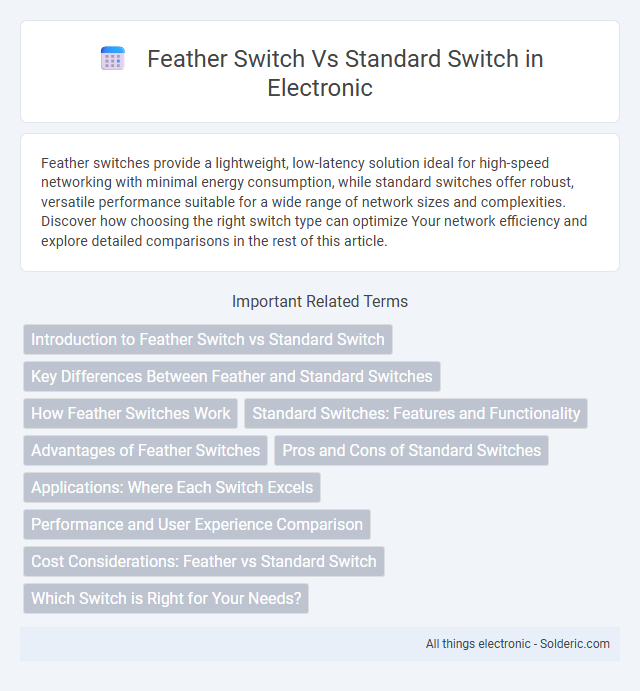Feather switches provide a lightweight, low-latency solution ideal for high-speed networking with minimal energy consumption, while standard switches offer robust, versatile performance suitable for a wide range of network sizes and complexities. Discover how choosing the right switch type can optimize Your network efficiency and explore detailed comparisons in the rest of this article.
Comparison Table
| Feature | Feather Switch | Standard Switch |
|---|---|---|
| Size | Compact, lightweight | Larger, bulkier |
| Durability | High-grade materials, rugged design | Basic materials, less robust |
| Switch Mechanism | Low actuation force, smooth tactile feedback | Standard actuation force, moderate feedback |
| Use Case | Precision tasks, gaming, fast typing | General-purpose, office use |
| Response Time | Faster, optimized for speed | Standard response speed |
| Price | Usually higher due to specialized design | More affordable, mass-produced |
Introduction to Feather Switch vs Standard Switch
Feather switches offer a lightweight, compact design that enhances portability and ease of installation compared to standard switches, which are typically bulkier and designed for more robust networking environments. Your choice depends on the specific network requirements, where feather switches excel in minimalistic setups and standard switches support higher port counts and advanced features. Understanding the differences in size, functionality, and deployment scenarios helps optimize network performance and scalability.
Key Differences Between Feather and Standard Switches
Feather switches feature a lightweight design with faster response times, making them ideal for high-speed, precision applications, whereas standard switches prioritize durability and general use with robust mechanical components. Feather switches often utilize advanced materials or sensors to enhance sensitivity and reduce actuation force, contrasting with the traditional, heavier construction of standard switches that favor reliability over speed. Your choice depends on whether you need speed and sensitivity or ruggedness and longevity in switch performance.
How Feather Switches Work
Feather switches operate using lightweight, low-profile materials that enable quick and precise actuation with minimal force, enhancing responsiveness in mechanical keyboards. Unlike standard switches, which often rely on heavier springs and bulkier components, feather switches use innovative designs to reduce key travel distance and improve tactile feedback. Your typing experience benefits from faster input recognition and reduced finger fatigue due to the optimized mechanical structure of feather switches.
Standard Switches: Features and Functionality
Standard switches provide reliable wired connectivity with multiple Ethernet ports, supporting speeds from 10/100 Mbps to 10 Gbps depending on the model. They include features such as VLAN support, Quality of Service (QoS) for traffic prioritization, and basic network management capabilities like SNMP and port mirroring. These switches are widely used in business and home networks for stable and secure data transmission across LAN segments.
Advantages of Feather Switches
Feather switches offer significant advantages including lightweight design, enhanced portability, and ease of installation compared to standard switches. Their compact form factor reduces space requirements, making them ideal for environments with limited room or for applications requiring frequent relocation. These switches also provide efficient power management and faster response times, improving overall network performance and energy savings.
Pros and Cons of Standard Switches
Standard switches offer reliable and straightforward network connectivity suitable for many office environments, providing consistent performance and ease of management. However, they can be limited in scalability and advanced features compared to feather switches, potentially leading to bottlenecks in high-traffic scenarios. Your choice depends on balancing cost-effectiveness with the required network complexity and future growth plans.
Applications: Where Each Switch Excels
Feather switches excel in applications requiring ultra-lightweight, low-profile controls such as wearable technology, portable medical devices, and compact consumer electronics due to their minimal actuation force and slim design. Standard switches are better suited for industrial machinery, automotive controls, and heavy-duty equipment where durability, tactile feedback, and robustness are critical. Each switch's specialized design optimizes performance for specific operational environments, ensuring reliability and user efficiency.
Performance and User Experience Comparison
Feather switches offer enhanced performance through faster response times and reduced latency compared to standard switches, making them ideal for high-speed gaming and professional multimedia setups. Their lightweight design contributes to improved user experience by providing tactile feedback and greater durability, reducing finger fatigue during prolonged use. Standard switches typically have slower actuation points and less precise feedback, which may affect typing accuracy and overall efficiency.
Cost Considerations: Feather vs Standard Switch
Feather switches typically offer a cost-effective solution for lightweight or low-traffic network environments by using fewer materials and simpler designs compared to standard switches. Standard switches, while generally more expensive upfront, provide greater scalability, higher port density, and advanced features that justify the investment for robust enterprise networks. Choosing between feather and standard switches depends on balancing immediate budget constraints against long-term network performance and expansion needs.
Which Switch is Right for Your Needs?
Feather switches offer lightweight, compact designs ideal for portable setups, while standard switches provide robust performance with higher port density suited for fixed network infrastructures. Choosing the right switch depends on factors like network size, mobility requirements, and budget constraints. Evaluating the need for scalability, power consumption, and management features will guide the decision between feather and standard switches.
Feather switch vs Standard switch Infographic

 solderic.com
solderic.com